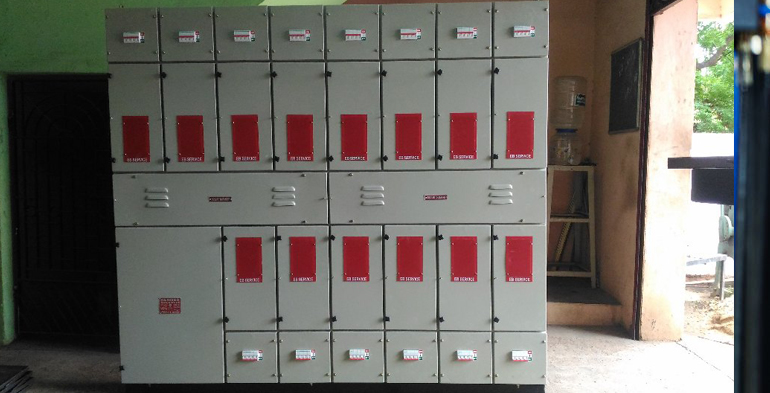
LCT METER BOARDS

Description of L.T.C.T Meter Boards (as per TNEB):
L.T.C.T Meter Boards, in adherence to the specifications outlined by the Tamil Nadu Electricity Board (TNEB), serve as the essential interface for accurately measuring and recording electricity consumption in low-tension electrical systems.
LT CT Metering Panel Board:
Low tension computed tomography (LT CT) panels are the computerized automated control panels which are very much efficient in controlling multiple electrical signals and circuits at a time. These LT CT panels are used for various industrial and electrically operated mechanical purposes to control the action and functioning of different systems in a very desirable manner. These LT CT panels are manufactured and constructed in a very advanced technological manner to provide a greater efficiency and reliability to it.
Low Tension Current Transformer (L.T.C.T) Meter Boards, compliant with the guidelines set by the Tamil Nadu Electricity Board (TNEB), are integral components in the measurement and monitoring of electricity usage in residential, commercial, and industrial settings. These meter boards are designed to meet the specific standards and regulations of TNEB. Here's a description of L.T.C.T Meter Boards as per TNEB:
Keywords
-
Transformer (CT): L.T.C.T Meter Boards are equipped with Current Transformers (CTs), which are designed to transform high electrical currents into measurable levels suitable for accurate metering.
-
Metering Instruments: The panel is integrated with TNEB-approved metering instruments, ensuring precise measurement and recording of electricity usage.
-
Safety Measures: Safety features, including circuit breakers, fuses, and other protective devices, are incorporated to safeguard the panel board and the connected electrical systems.
-
Tamper Resistance: Measures are taken to deter tampering and unauthorized access to metering equipment, ensuring data accuracy and integrity.
-
TNEB Compliance: L.T.C.T Meter Boards conform to the strict regulations and standards set by TNEB. Compliance is crucial to maintain the accuracy of electricity billing and distribution processes.

Applications:
L.T.C.T Meter Boards find application in various sectors
- Residential: In residential settings, these boards are instrumental in monitoring and billing electricity usage for individual homes.
- Commercial and Industrial: Commercial establishments and industrial units use L.T.C.T Meter Boards to ensure accurate billing and efficient electrical distribution.
- Public Infrastructure: L.T.C.T Meter Boards are employed in public infrastructure projects, such as schools, hospitals, and government facilities, to measure electricity consumption.
Purpose of Low Tension Current Transformer (L.T.C.T)
- Metering and Billing: L.T.C.T Meter Boards are primarily used for metering electricity consumption. They house electrical meters and current transformers that measure the amount of electricity used by a specific circuit or area. This data is crucial for accurate billing of electricity usage, allowing customers to be charged based on their actual consumption.
- Data Collection: The meters and associated equipment in L.T.C.T Meter Boards collect data on electricity usage, including the number of units consumed over time. This data is essential for billing, energy management, and tracking usage patterns.
- Load Monitoring: These boards help monitor the electrical load of individual circuits or areas. Load monitoring is important for ensuring that circuits are not overloaded, which can lead to electrical issues, safety concerns, and inefficiencies.
- Energy Efficiency: By providing accurate data on electricity usage, L.T.C.T Meter Boards enable consumers to monitor their energy consumption and make informed decisions about energy efficiency. This can lead to reduced energy costs and a smaller environmental footprint.
- Safety and Protection: L.T.C.T Meter Boards often include protective devices like circuit breakers or fuses. These safety measures help prevent electrical overloads, short circuits, and other electrical faults that can be hazardous to both people and equipment.
- Tamper Detection: Many L.T.C.T Meter Boards are designed to detect tampering or unauthorized access. Tamper-resistant features are important for maintaining the integrity of billing data and preventing electricity theft.
- Data Communication: In modern installations, L.T.C.T Meter Boards may also incorporate communication capabilities, such as remote data retrieval. This enables utilities to collect data without physical visits and allows customers to monitor their electricity usage in real-time.
- Compliance and Regulation: L.T.C.T Meter Boards must comply with the regulatory standards and guidelines set by electricity distribution authorities, such as state or regional electricity boards. Compliance ensures that the measurement and billing of electricity usage are accurate, fair, and transparent.
